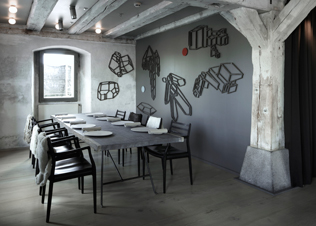News
A visit to Noma: the future of food
Tuesday, June 25th, 2013
You have to keep a sense of humour when at the pinnacle of fine dining.
This was highlighted when I had the pleasure and privilege of eating at Noma restaurant in Copenhagen earlier this year (still no.1 according to World’s 50 Best Restaurants at the time). The water served was tapped directly out a birch tree, one dish was seasoned with ants rather than pepper and we ate twelve dishes before we actually started the menu. I also ate a live shrimp in the kitchen afterwards, drank some of the best wines of my life and chatted at length with René Redzepi.
The whole experience almost bankrupted me, yet I can’t wait to go again. Quite a laugh, really.
The recipe for success
What lingers longer than the smell of your burnt credit card is the understanding that Noma is about far more than eating: it’s an experience born out of a unique mix of talent, energy, geography and yes, humour. As Redzepi himself said at 1am in the kitchen, “Choosing to be a chef is a sort of self-martyrdom.” He was smiling at the time, but this may not have been a joke.
Food is just 50% of what makes Noma so incredible. The rest comes from the location, service, drinks and general attitude and energy of the place. When you fill a restaurant with guests who have mostly travelled across the world to be there, you get a lot of energy. Exactly the same goes for the kitchen team.
But the food is memorable, and the single most memorable aspect is that the general approach to food has completely changed. When El Bulli rode the crest of the fine dining wave, it was all about techniques: how to do crazy things to food to achieve unique results. This birthed molecular gastronomy and years of foamy knockoffs in restaurants around the world.
Inventing ingredients at the Nordic Food Lab
Thankfully, we’ve moved on. At Noma, almost everything is cooked in an oven, fried in a pan or grilled in a Big Green Egg out back. The future of food is new ingredients, what we choose to use and how we use them. Which is exactly what Noma excels at: using ingredients you wouldn’t expect and creating new flavours from them.
Noma owes much of its success to the Nordic Food Lab, a floating laboratory a stone’s throw from the restaurant that Redzepi established to explore “the building blocks of Nordic cuisine.” There, a team of decidedly curious chefs and researchers solve things like how to shuck bee larvae and ponder the complexities of lactic acid fermentation. Recently they received a large donation to focus their attention on how to make insects delicious to the Western palate.
That blurring line between the edible and inedible is a big part of what makes Noma successful, and what drives the Nordic Food Lab. Naturally, they’ve unearthed a host of ways to prepare ingredients others wouldn’t even consider worth eating. Their important shift in mentality is the future of food: that there are many things we don’t eat that are perfectly edible and we should find ways to make them delicious.
This opens up a whole new world of possibilities. Things like insects, moss and bark can be made tasty. It’s actually not that obscure when you consider some of the most intensely flavourful ingredients in your kitchen. Soy sauce is made from soya bean paste fermented with a fungus. Worcester sauce gets its high umami level from fermented anchovies.
Locally, ingredients like rooibos and buchu are barely the tip of the indigenous flavour iceberg for innovative chefs. The future of food is the abundance of unused ingredients everywhere around us. We just have to learn to prepare them and be open to their new tastes.
After all, consider the lobster. Less than 200 years ago, lobster was thought of as barely edible and fed only to prisoners. Today the price of lobster on a menu… Well, let’s just say it calls for a good sense of humour.
By David Cope
Photograph: Thomas Ibsen












